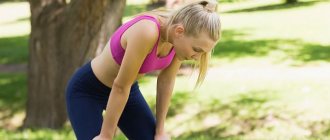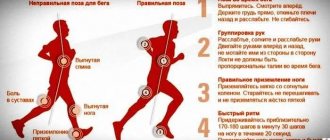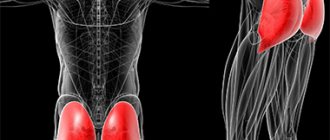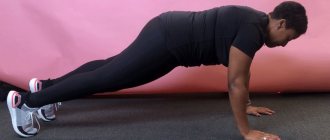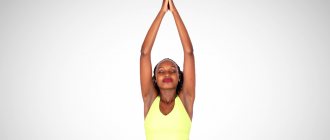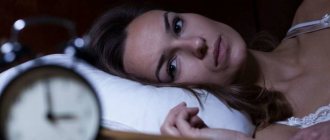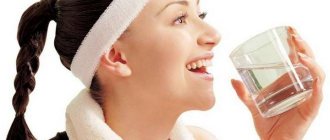Causes of knee pain after running
It is not easy to immediately determine why your knees hurt from running. There are many reasons:
- joint pathology;
- meniscus injury and subsequent rehabilitation;
- ligament damage;
- inflammatory process;
- vascular circulation disorders;
- other reasons.
If initially there are no pathologies and inflammation of the joints, then the knees can get sick from the load, the volume of which they are not able to cope with.
Knee pain after running is not uncommon, but a very pressing problem for a large number of people who are keen on running.
At the first stage, painful sensations appear at the limit of physical strength and disappear immediately after the end of the workout. If these symptoms are neglected, then severe pain occurs from the first minutes of jogging and does not go away for several hours after. In the future, if no measures are taken, the pain in the joint will last up to 3-5 days.
If acute pain lasts more than a week, it means there is an inflammatory process in the ligaments or joint, hospitalization and emergency treatment will be required.
What mistakes lead to knee pain?
- If your knees hurt after running, it may be the consequences of improper running technique.
- Painful sensations are caused by running over rough terrain. Uneven surfaces are not suitable for foot support. As a result, the load on the knee joints increases.
- Running with unreasonably excessive heel support leads to joint deformation and compression of cartilage tissue.
- Flat feet can also cause your kneecaps to malfunction while jogging.
- Shoes that fit poorly on your feet, tight or, conversely, too loose, do more than just cause discomfort. It leads to injuries even when running on asphalt.
Errors in running technique are more common among people who start running. If you pay attention to this in time, pain in the knee joint will be less likely. But even with proper, highly technical running, excessive loads will lead to fatigue and can injure the knee joints.
There is a “risk group” that includes people:
- overweight;
- with flat feet;
- no experience of running or physical activity;
- with previous injuries and operations of the musculoskeletal system, in particular the knee joint;
- aged people.
So running is not for everyone. People with osteochondrosis, scoliosis, arthritis and arthrosis of the joints should absolutely not abuse running. In such cases, a set of supportive exercises is recommended.
The pain occurs due to friction of the so-called iliotibial tract against the lateral condyle of the femur.
Pain in muscles and joints during adaptation to the start of training or increased loads is inevitable. Such unpleasant sensations are temporary and go away after two or three sessions. But if the pain is acute, localized in one specific place, for example, under the knee, or your knees hurt or simply crack when bending, and do not go away for more than a week, there is reason to consult a doctor. Since there are signs of microtrauma or inflammation.
Discomfort after childbirth
The pregnancy period is also characterized by increased stress on the body, so knee pain may appear in the postpartum period. When carrying a child, changes in posture are inevitable. A woman's weight increases due to her growing belly.
This entails increased pressure on all joints, including the knees. In addition, after the birth of a child, weight decreases sharply. Such changes also negatively affect joint health.
Knees hurt after childbirth for the following reasons:
- lack of calcium in the body;
- uncomfortable position for feeding the baby;
- decreased activity during pregnancy;
- carrying a child in your arms.
During pregnancy, the female body actively synthesizes the hormone relaxin, under the influence of which the knee ligaments can soften.
During childbirth, dislocation of the knee joint may occur, which subsequently manifests itself in regular pain.
In some cases, pain in the knee joints is associated with complications after anesthesia.
If pain occurs during training or competition
If the pain in the knee joints began acutely, suddenly, during training and, as often happens, even in competitions, a reasonable solution is to stop running, “leave the race” and ask for first aid:
- You can't stop suddenly. Abruptly stopping movement will aggravate the injury. First you need to start walking quickly, then slow down, then stop.
- Free the joint from constrictive clothing and apply a tight elastic bandage or bandage.
- Apply ice wrapped in a cloth or apply a cold compress to relieve soreness. Freeze for five minutes, repeat three times.
- Place your foot on the backing above the horizontal.
- If the pain is severe and does not go away, take an anti-inflammatory pain reliever.
- Regardless of how long the pain lasts, you need to see a doctor. This single attack can be the beginning of a serious disease such as arthritis or arthrosis.
What to do if there is pain
Do not wait for the pain to go away on its own; go to the doctor immediately.
If the pain is severe, you can take any analgesic, but this will only drown it out without getting rid of the cause itself.
Over time, the pathology will begin to progress, bringing even more inconvenience.
The first actions during pain should be the following::
- Do not put stress on the sore joint. It is advisable to secure the knee with a bandage or tight bandage.
- To reduce swelling, the leg is placed on a hill so that the foot is above the level of the heart.
- In the first two days, apply cold to the sore spot for 10 minutes. This is done up to 4 times a day. If you take ice, be sure to wrap it in cloth to prevent hypothermia.
- Take painkillers as prescribed by your doctor. These can be analgesics and non-steroidal anti-inflammatory drugs, which will not only eliminate pain, but also relieve the inflammatory process.
ATTENTION! In the future, you can use ointments to warm up.
Can you tolerate knee pain?
If knee pain after jogging, working out in the gym, or in older people, is constantly bothering you, you should urgently consult a doctor. Only a doctor will find the causes of chronic illness and make the correct diagnosis, on which the success of treatment depends.
- For chronic pain you will have to:
- Adjust physical activity, intensity and frequency of training.
- As prescribed by the attending physician, take bioactive supplements that support joint function and restore cartilage tissue - chondroprotectors. These new generation products are free of side effects, non-hormonal, act specifically on the affected areas of the joint, relieve symptoms, and have a natural composition.
- Immobilize the joint during loads - wearing a bandage or elastic bandage.
- Use warming ointments for joint pain. Warm compresses.
Before starting training, do not neglect warming up, work and warm up all muscles and joints. Pay special attention to special exercises for the knees.
Very characteristic pain sensations that appear towards the end of the workout. The pain increases with acceleration.
Harm or benefit of a bicycle
A bicycle combines a means of transportation and a universal exercise machine.
However, riding it significantly affects the condition of the knee joints, as one of the most vulnerable places of the musculoskeletal system.
Like any other sport, cycling requires preliminary preparation of muscles and joints. Neglecting a good warm-up can lead to internal damage to the knees. The joint lubrication that protects the kneecap quickly runs out in the cold season.
The load increases, and with it the risk of injury increases. The amount of lubrication directly depends on the fluid consumed during training; dehydrated joints become fragile.
Driving style also affects the condition of the knee joints. When pedaling slowly, the load on the joints increases, and, consequently, knees hurt more often after cycling.
Improvement and strengthening of knee joints, joint gymnastics
Knee pain after exercise is easier to prevent than to treat. To do this, take it as a rule:
- Running on a flat surface, road, asphalt, where there are no holes, ruts, protruding or lying stones on the surface.
- Technical running, which involves placing the foot straight on the heel with a smooth roll to the toe.
- The right shoes are ones that are specifically designed for running, that support the arch of the foot, secure the ankle, have a firm heel and soft toe. The lacing should be neither weak nor tight.
- The training process is carried out under the guidance of a specialist. Increase the loads gradually, without overstraining the knee joints.
- Before starting exercise, perform a warm-up to warm up the muscles, and at the end - a cool-down stretch.
Gymnastics for the knees, exercise therapy, fitness, rehabilitation in the gym play a role. Sports doctors have long begun to develop therapeutic, strengthening exercise programs. Knee joint disease can be cured with timely medical attention and proper rehabilitation practices. Knee strengthening exercises are part of the process to help reduce the risk of knee injuries. Exercises for knee pain are aimed at:
- strengthening weak muscles;
- maintaining joints in working order;
- stretching;
- relaxation.
Let's look at some groups of exercises for knee pain, but there are few options. The knee joints take an active part in all movements. Knee injuries are common in the sports world. The question of how to replace squats if your knees hurt is relevant for many. It's hard to find an alternative to glute exercises that doesn't put stress on your knees.
During the rehabilitation period, it is useful to replace running with cycling and swimming. These sports will help strengthen your damaged knees.
A simple exercise will help restore joint mobility: while lying on your back, alternately bend and pull your legs towards your chest. The “bicycle” and “scissors” exercises are useful.
Sometimes pain occurs at the beginning of a run, after warming up it decreases - but towards the end of the workout it still returns.
With the gradual restoration of motor function of the knee, they return to jogging. But you need to start with loads that are much less than usual, and avoid running on inclined and rough terrain. Doctors do not recommend running to lose weight. Excess weight prohibitively increases the load on the knee, hip joints, and bones. To reduce the risk of injury, it is better to replace running with race walking.
Running, jumping, sports games, and team sports such as football are also not recommended for older people. It is dangerous to suddenly squat, squat and stand up. Physical education, exercises in water, vigorous walks in the fresh air will not cause harm to the body.
The essence of exercises for periodic pain in the kneecaps is to strengthen the thigh muscles: abductors, adductors, flexors, extensors. For problems with sore knees, the most preferable activities are:
- with the barbell in a position on the chest or at hip level;
- in a hack machine for basic training of the muscles of the front and back of the thigh;
- spreading the legs to the sides, training the inner and outer surfaces of the thighs.
If there is a risk of knee pain, weight loads should be low and the number of approaches should be small. Here are some more examples of useful exercises to reduce pain:
- Squat against a wall. Feet are shoulder-width apart, the back is located strictly along the surface of the wall, shoulders, shoulder blades, and lower back are pressed tightly. Slowly lower yourself, sliding along the support until your legs are at 90°. Hold the body in this pose for 1-2 minutes. Perform 3-5 approaches daily.
- Hip abduction from a side lying position. Lie on your side, with your leg lying on the floor comfortably bent at the knee, and lean on your arm extended or bent at the elbow. Keep the other leg lifted off the floor. Slowly raise your leg up to the maximum limit, keeping the lateral inner surface of your foot parallel to the floor. Hold your leg in the upper position for three counts. Just as slowly return to the starting position. Perform two sets of 10 repetitions on each leg.
- Raising a straight leg from a supine position. Lie on your back, press your shoulders, shoulder blades and lower back firmly to the floor. Bend one leg at the knee, straighten the other along the floor, keep the foot perpendicular to the floor. Slowly raise your straight leg to an angle of 45°, hold for three counts and slowly return to the starting position. Perform two sets of 10 repetitions on each leg.
If you feel that the fabrics cannot stand it, then you need to be able to stop in time. Run in good, proper shoes and change them regularly.
Professor Bubnovsky developed exercises for the knee joints several decades ago and they are still relevant today. When they are performed, natural regenerative processes in joints, ligaments, connective and cartilaginous tissues are activated. Pros and cons of the Bubnovsky system:
- improving the condition of the body as a whole. The process is lengthy, requiring persistence and punctuality;
- no need to take medications. The need to strictly adhere to the instructions of the physical therapy instructor;
- With regular use, some pathologies disappear and there is no need for surgical intervention. Non-medicinal practice is associated with unpleasant painful sensations in the affected joints;
- suitable for everyone, has no contraindications, and is used as a means of preventing diseases of the musculoskeletal system.
Detailed text descriptions and video instructions can be downloaded on the Internet. Taking multivitamin complexes, warming up before running, proper technique, comfortable shoes, and monitoring your own well-being will help you avoid unpleasant consequences.
Vascular disorders
When the blood vessels that supply the joint area are damaged, intermittent pain appears. They do not have a clear location of defeat; they go away on their own. This disease mainly affects teenage children. Bone growth occurs faster than vascular growth. Also, the cause of circulatory disorders can be the appearance of cholesterol plaques, narrowing the lumen in the blood vessel.
There are factors that lead to improper joint movements, which over time will lead to inflammation. Ligament sprains can also occur, and meniscal injuries become chronic. This may be caused by:
- Running on an uneven surface. There is an uneven load on the joints, microtraumas constantly appear, contributing to the development of chronic inflammation and the appearance of pain;
- Incorrect running technique. This occurs due to poor leg or body position while running. The vertical load on the joint becomes greater, this causes compression of the structures and tissues of the joint;
- Flat feet, in which there is an uneven arch of the foot, so the leg cannot spring correctly when running, which causes stress on the knee;
- Shoes that are chosen incorrectly. Do not choose shoes that are too loose or tight;
- Lack of warm-up. Before running, you should definitely warm up, as untrained muscles will warm up unevenly during running, which will cause improper joint movement.
Bandage for knee pain
A special bandage supports the joint and helps overcome knee pain. It is selected individually by a sports doctor or orthopedist. You should not get carried away and wear it constantly, otherwise there is a high risk that the muscles will get used to the additional support and begin to weaken. The decision on the timing and mode of wearing the bandage is made by the attending physician together with the trainer.
In some cases, bandages can be useful. But, firstly, it must be selected by a sports doctor. Secondly, the bandage should be solely a means of aiding recovery, and not a permanent element.
Causes of pain in the feet
There can be many causes of foot pain. Here are the most common ones.
Flat feet
This is a disease that could have been diagnosed in childhood. Due to flat feet, the arch of the foot becomes flat, so it can almost completely lose its shock-absorbing properties.
A person’s legs hurt a lot after a long walk or run. It is interesting that representatives of the fair half of humanity suffer from this disease several times more often than the stronger sex.
If flat feet are neglected, it can lead to arthritis or arthrosis, and can also cause pain in the calves, back, and curvature of the spine.
Flat feet manifests themselves as follows:
This is a fairly common occurrence. Due to a bruise, pain appears in the foot, the foot swells and swells, and bruises appear on the skin.
Sprained or torn ligaments
A sprain can occur after you have played sports or experienced tremendous physical activity. Because of this, severe pain appears in the foot, and the foot also swells.
If the ligaments are torn, then the pain is sharp and sharp, and the foot may hurt, even if you are sitting or lying down, it is impossible to step on it.
Fracture
During a fracture, the foot hurts very much, it is impossible to step on it.
Arthritis of the foot joints
With this disease, pain occurs in the foot, under the toes, swelling appears, and the joint becomes stiff. In addition, the skin over the joint turns red and feels very hot to the touch.
Tibialis posterior tendinitis
With this disease, aching pain appears in the foot, which goes away after you have rested. However, if the disease is neglected, then this pain can become chronic, it will not go away after rest, and will also intensify with movement - running and even walking.
Valgus deformity of the thumb and little finger
In this case, the little toe or big toe will shift towards the other toes on the foot, and part of the joint on the inner or outer part of the foot will undergo enlargement.
Metatarsalgia
Pain appears in the sole of the foot, and it becomes impossible to lean on the foot because of it.
Plantar fasciitis
It manifests itself as follows: the heel or part of the sole inside hurts. Typically, acute pain can occur in the morning when a person gets out of bed, and disappears during the day.
Heel spurs
With this disease, it is difficult for a person to move (and even stand) due to very severe pain in the back of the foot.
Achilles tendinitis
This disease manifests itself as sharp and shooting pain in the back of the foot and lower leg. Your feet may hurt if you start moving after a long period of rest.
Osteoporosis
This is a disease that reduces bone density. Osteoporosis can cause our bones to lose their strength, become brittle and break easily. Most often, this disease occurs in older people, while representatives of the fair sex suffer from osteoporosis three times more often than men.
Phlebeurysm
This disease manifests itself as a feeling of heaviness in the legs and feet. And in the later stages of varicose veins, pain in the foot also occurs.
Obliterating endarteritis
This disease manifests itself in the fact that the foot may become numb, there is aching and chronic pain, and acute pain may also occur if you are hypothermic. Also, ulcers may appear on the foot, and the person may begin to limp.
Diabetic foot
This is one of the complications of such a disease as diabetes. The disease manifests itself as swelling and pain in the foot, in addition, ulcers may form on the skin. The foot may become numb and the legs may feel weak.
Ligamentite
This disease manifests itself in the form of inflammation of the ligaments, and the inflammation, in turn, causes pain in the foot. In this case, pain can be in the instep, on the sole, on the side, and also in the ankle area.
Gout
With this disease of the kidneys and joints, uric acid accumulates in the body, metabolism is disrupted, uric acid salts are deposited in the joints and skin, forming “nodules.” This disease must be treated.
Gout causes sudden pain in the foot, especially in the toes. Swelling may also form and the skin becomes hot in the area of pain.
Mistakes in self-medication
Self-medication for sore knees most often comes down to taking painkillers - drugs like Ketorol, Nimesil, Diclofenac, etc. They do not provide practical help for sore knees, and only aggravate the situation. The second common mistake is returning to normal sports mode prematurely. Athletes want to get back into their previous shape as soon as possible.
Therefore, if your knees hurt when squatting and standing up, how to treat them with folk remedies, you need to understand the complex nature of knee problems, recognize the problem and find an adequate solution.
Is running bad for your joints?
There is always harm to joints during active physical activity. While running, the load increases. When a person places emphasis on one leg, he transfers his body weight to it. The knee joint receives a shock portion of this load - it is most actively exposed to danger.
On the one hand, a similar process occurs during walking. The body weight shifts first on one leg, then on the other, but it is running that destroys the joints faster. This occurs because the body's mass is multiplied by the acceleration force. And the faster we run, the more noticeable the negative impact will be, as the load increases.
It is also necessary to take into account that running can be different - jogging, sports, long strides, with complex elements, classic. When creating support on one leg, a person puts stress on different joints and the musculoskeletal system. The longer the step, the greater the support, the more time it takes to perform the action. This creates conditions for increased load.
The safest running is slow, in small steps. In this case, the joints are subject to less intense destruction, and the risk of inflammatory processes is reduced.
Prevention
- Excess weight causes knee pain - proven by specialist research. This applies to both athletes and people who are far from physical education.
- Loads that exceed permissible levels cause great harm. Don't pretend to be Hercules when lifting weights, but know your limits of physical exercise. Perhaps you should consider taking exercise therapy.
- If you run, wrap your limbs with a special sports bandage - tape.
- Correct your diet by eliminating bad cholesterol, which causes plaque. Try to eat more vegetables and fruits, gradually removing salt and fatty meat from your diet. Take vitamins that will strengthen bone and cartilage tissue.
- If necessary, agree to surgery to restore hip function. This intervention is called endoprosthetics and consists of replacing a diseased organ with an artificial one. After surgery, rehabilitation is important, requiring wearing an orthosis, dietary nutrition and performing certain exercises.
- Alternative medicine can be included in the main activities: folk recipes, compresses, rubbing, herbal baths.
There are plenty of reasons for pain after a run. Some are easy to eliminate by purchasing new sneakers, while others require a specific approach. If the case is serious and the disease has already been diagnosed, then treatment cannot be delayed. Joint diseases develop quickly, which leads to irreversible changes in the body.
Source artritox.ru
If your legs hurt after running, this may indicate many factors, both normal and pathological. It goes without saying that there is no need to endure pain. Thanks to a competent approach to running work, unpleasant consequences can be minimized or eliminated altogether.
